In my account of my childhood, I have roughly divided the time periods according to where we lived (our residences) since it facilitates my memory recollection, but many of the described phenomena existed through several such periods, and some throughout my childhood. The idea is to give a flavour of the colorful environment in my childhood, highlighted by detailed descriptions here and there. I am brought up as Hindu at home, but I have had around me Muslims and Christians, and different asian groups, arabs, europeans, africans. My parents emigrated from India around 1930, from a state called Gujarat, so my mother tongue is Gujarati, which is derived from Sanskrit (like Hindi and many languages of northern India; however, many languages in southern India are not Indo-European).
The "old house" (junu ghar) (1948-1952):
My earliest memories from my childhood in Mombasa, Kenya, are from about 3 to 4 years of age. I know this because my younger brother Dhanesh was born in 1952 when I was 3½ years old, being born in 1948. (Research shows that adults can remember specific events from childhood only from about 3 to 4 years of age, on the average 3½ years of age). I can faintly remember Dhanesh lying in a basket-like cot (crib) on a soffa. We siblings were curious and cautiously excited, and I remember the typical baby smell when I gave him a soft kiss on his arm. When he was born, I had no idea that he would grow up to be a very generous, unselfish, and caring person. Dhanesh is now 54 years old, living with his equally generous wife Chandrika and his son Kiran in England. Dhanesh and Chandrika have taken care of our parents in their old age until they passed away (my mother in 1989 and my father in 1999), with love and without complaints, thereby making it possible for me and my siblings to pursue our own studies and development. Their home is like a temple, welcoming and warm, and all of us relatives usually stay at their home whenever we visit England.

Dhanesh in 2005, age 53, with his wife Chandrika.
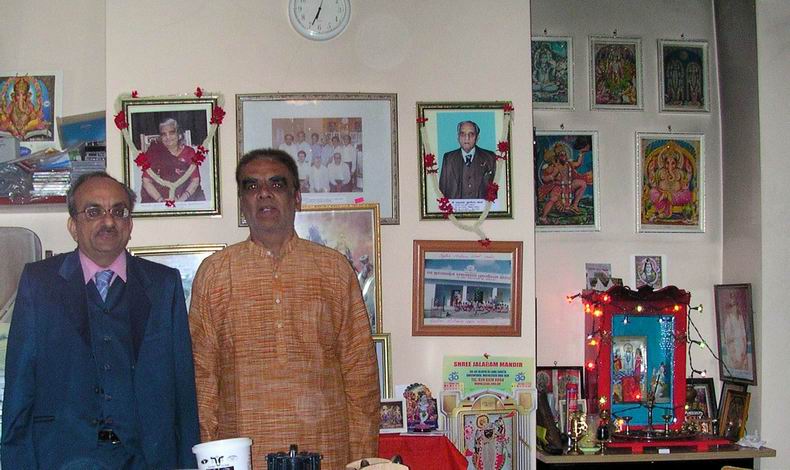
Dhanesh's home in London is like a mandir, inspiring me to dress up traditionally on occasions.
During all the years in Mombasa, we shifted between many different rented residences, I would think to better places, in pace with our economical situation getting better. Since I had many caring elder siblings (I am the third youngest among totally 2 sisters and 8 brothers), I had never experienced this as any problem or any source of insecurity. We are used to referring to each residence by some nickname.
When Dhanesh was born, we were living at a house nicknamed the "old house" (junu ghar), where, as I have understood, the family lived from 1941 to 1952. This house was not far away from Fort Jesus and the Old Port (see pictures below). So including Dhanesh and me, we are 5 brothers born in this house. Our eldest sibling, our sister Manuben, got married in 1951 when I was under 3 years of age and moved to Uganda, so I do not have childhood memories with her from home, although subsequently we have developed many strong bonds, and after my mother passed away in 1989, she is like a mother to us.
The "old house" consisted of an eastern toilet on the ground floor, and stairs leading to the residence on the first floor. It was not uncommon to see a mouse suddenly running very swiftly along the walls in the room we were sitting and chatting. The mouse ran from one hiding place to another hiding place, which could be some hole in the walls or in the soffa. We used a mousetrap now and then, although my parents were in principle against it since they did not believe in killing animals. We placed the mousetrap under the bed or under a bench in the hall, or in some corner where we suspected the mouse had a habit of visiting. I remember that when I woke up in the morning, I used to be eager to go and see if we had obtained "a catch", which often consisted of a dead mouse with the neck and head crushed in the trap.
Then there were cockroaches of different sizes emerging here and there, and lots of them at times disclosed their presence when some old unused drawer was opened. These phenomena were found even in the subsequent residences we moved to. We used DDT in those days.
Cockroaches & a bottle with DDT. DDT was banned in 1970 (in 1972 in the USA), but today there is a lot of discussion to re-introduce DDT to combat malaria, where it has a substantial proven effect. Extensive information about DDT and fighting malaria can be obtained if you click here.
I took photos of the area around where the "old house" was when I visited Mombasa in 1996 and 2005; the "old house" has been destroyed and a new white-walled building exists in its place. However, most of the buildings in the neighborhood remain, which also tells us how old the "old house" must have been.
The "old house" location (marked *) and its neighborhood.
Mombasa during my childhood was a very colorful town, with many ethnic groups around, like the europeans, the various subgroups of asians speaking gujarati, punjabi, hindi or urdu, the arabs, and the indigenous Swahili people speaking Swahili. It is an island, connected to the mainland by a bridge each to the north and the west, and by Likoni Ferry to the south.
Over the centuries, there have been many immigrants, particularly from the countries of the Middle East and Indian sub-continent, who came mainly as traders and skilled craftsmen, and even after four or five generations, their descendants continue to contribute highly to the economy of present day Mombasa and Kenya as a whole. Recent immigrants are people from the interior of Kenya brought to the area by employment opportunities in the tourist industry.
The town of Mombasa was founded by Arab traders around the 11th century. Vasco da Gama was the first known European to visit Mombasa, receiving a chilly reception in 1498, but the town was sacked by the Portugese in 1500. It was taken over by the Arabs into a sultanate in 1502, but the Portugese attacked again in 1528, and built the Fort Jesus in 1593 in an attempt to colonise, and in 1638 it formally became a Portugese colony. In 1698, Mombasa came under the suzerainty of the Sultanate of Oman. Then followed a period of takeovers and counter-takeovers by the arabs, the portugese and the british.
Fort Jesus in Mombasa, built by the Portugese in 1593.
In 1887, Mombasa's administration was relinquished to the British East Africa Association. Then it became part of Britain's Kenya protectorate (the coastal strip nominally under Zanzibari sovereignty) in 1895, and in 1896 the Uganda Railway was started, when many workers were brought in from the then British India to build the railway. In 1963, Mombasa was incorporated into the newly independent state of Kenya.
 Flag of independent Kenya from 1963.
Flag of independent Kenya from 1963.
Since Kenya was a British colony during my childhood (became independent in 1963), the government was run by the "whites", and the commanders of the police cars were whites, and sometimes indians (sikhs). The small shops selling softdrinks, fruit, sweets and bathroom articles were owned by the arabs. The somewhat bigger shops selling all sorts of things in the commercial streets were owned by the asians, except for the really exclusive ones owned by the whites. Some of the Swahili people also had some small corner shops, but otherwise they sold in the evenings roasted cassava or maize, were hawkers, and a lot of them were employed in domestic services like dishing, washing and cleaning.
The "Narshibhai house" (1952-1953)
I would think that the "old house" must have become uninhabitable, because we moved towards the end of 1952 to stay in a temporary residence for at most a year, which is nicknamed "Narshibhai house". It was somewhat better in standard, on the first floor.
The "Narshibhai" residence (yellow, first floor, rebuilt, 2005), and the owner of the shop lying to the right, Mr Laxmidas (left), and his son (middle) (taken 1996). When I visited Mombasa in 2005, I learnt that Mr Laxmidas had passed away. Mr Laxmidas was a friend of my father. When his daughter got married around 1957, my father helped him with the marriage arrangements, and when my sister got married in 1959, he helped my father. Indian (Hindu) marriages (at least in those days) used to last several days, with many guests travelling from far. Both expensive and strenuous, but filled with feasting, enjoyment and socialization. When the main marriage ceremony is over during the last evening, lots of tears are shed by the girl's relatives as well as by the bride, as she slowly walks with her new husband towards a vehicle that will take her to the home of her husband, which she will consider her new home thenceforth. I would guess that the one who sheds least tears is the groom...
Some day before a Hindu marriage, the mehndi night is filled with family and friends painting their hands with intricate designs of henna paste (mehndi). During the marriage, the groom puts on his bride a mangalsutra, which corresponds to the western wedding ring. The mangalsutra usually consists of a gold ornament strung from a yellow thread, a string of black beads or a gold chain. The groom also places a special red powder between the parting of the brides hair (sindura danam). This red line identifies the bride as a married woman. |
Some of the good memories that come to my mind from Narshibhai house are those of Diwali, the first Diwali I can recall from this age of about 4 years. Diwali is a festival of lights, usually in October or November, decided upon according to the Hindu calendar.
I remember, on the early morning of Diwali, my (elder) sister Hemlata woke us up, and gave us a small packet with firecrackers, which my father/brothers had bought the previous day. We stood on the balcony and fired the crackers, very exalted.
Firecrackers came from China. My choice at that time was the smallest one.
"Station walla" house (near the railway station) (1953-1954):
As I describe on my page My education, I started my nursery school towards the end of 1954, when we were living at this residence near the railway station.
This house was on the periphery of Mombasa, and it was a little like living in the countryside. We were excited about being able to grow vegetables around the house. My brother came in with fear and excitement when he found a big snake (a small python??) lying under the wooden pieces he was picking up. I also remember that my brothers used to scare me with the goats that were around (not ours), and they said that I had woken up a few nights, screaming that my brothers were getting the goats to bite me.
Hemlata about 20 years old |
A very welcome event in my childhood was when my second sister Hemlata, now 68, came with her children to Mombasa by train; her husband was from a small town in Uganda. She got married in 1959, so I remember her wedding. After having waited at the train station eagerly, there comes this "giant, noisy, steaming machine with hot fire in the engine". When she is returning to her home, many tears are shed at the railway station, and when the inevitable moment comes, we hear a loud whistle with a lot of steam, and the train starts rolling, first slowly but speeding up. When I stared at the moving train, I felt as if the platform was moving in the opposite direction instead, and the train was standing still. Hemlata with my daughter Sara during wedding days, Canada, 2004. ↓ |
 |
|
Around 1954, when my brother Dhiraj was 10, Krishna was 12, and Vishnu was 14, they were sent on a two-week holiday trip to the island of Zanzibar. Zanzibar had a reputation of being very country-side like and the risk of getting malaria was high there. Malaria is still today a serious disease in spite of a lot of effort going on to fight it. We had the family of a distant father's-uncle-relative living in Zanzibar. Actually, this relative is the one who helped my parents to migrate to Kenya around 1930. At that time the ship journey from India's Porbandar to Kenya's Mombasa took two to three weeks, often with strong winds in the ocean, making the ship rock unpleasantly, and it was well-known that a large number of the passengers were prepared to vomit sooner or later during the trip. Zanzibar was at that time under the suzerainty of the Sultanate of Zanzibar, and was a British protectorate like Mombasa. Zanzibar obtained independence from the UK as a constitutional monarchy in December 1963, but the Sultan was overthrown in January 1964 and Zanzibar became a part of the then Tanganyika, the union known as Tanzania.
Anyway, off went my three brothers on the Zanzibar trip. Krishna was already then religiously inclined, and he repeatedly did the "mala", a string with 108 beads. On return from Zanzibar, both Dhiraj and Vishnu had malaria, but not Krishna. We had then the belief that it was because of Krishna doing the mala. I still remember my brothers looking pathetic, shivering as the fever was rising, and then feeling very hot and sweaty.
Different "malas" containing 108 beads, used by many to keep track of the number of times they chant whatever is pious to them.
Actually, when I think of Zanzibar, I get a strange feeling. This is because, later on in December 1958, it was planned that four of us siblings would also take a trip to Zanzibar, this time my sister Hemlata 20, Dhiraj 14, Vasant 12 and me 10 years of age. Almost all the preparations were made. It was then very important with certain vaccinations, which we were used to taking according to schedules. But when my father came to the window in the queque to finally buy the tickets, the ticket seller was on the verge of issuing the tickets, when in the last second he looked again at the vaccination forms and found out that one of us had a vaccination certificate that had expired a few weeks back. So our hopes of visiting Zanzibar, which we had very much looked forward to, were shattered, we were disappointed! I have thus never visited Zanzibar. But my father and the family came up with another holiday proposal which actually turned out to be very pleasant, and which I still remember with joy and some sort of melancholy (because it is gone, and remains only in my memories). We went instead to my sister Manorama and family in Jinja, Uganda! This trip is discussed elsewhere.
My wonderful, wonderful, Mombasa!
We are 8 brothers and 2 sisters, all born at home, as was the case in those days. I recall when Dhanesh was born, that a "midwife" helped my pregnant mother in the home until it was time for delivery, when the doctor was called home. My father, together with the midwife and the doctor, diappeared "behind closed doors" in the room where my mother was lying. And after some time a baby cry was heard, signalling the arrival of the sibling. I recall this process still more vividly when my youngest brother Jagdish was born in 1957, since I was then 8 years old. In this latter case, I also remember having obtained, together with my siblings, the assignment of burying something in the soil in the nearhood, which I have understood afterwards was the placenta (the afterbirth).
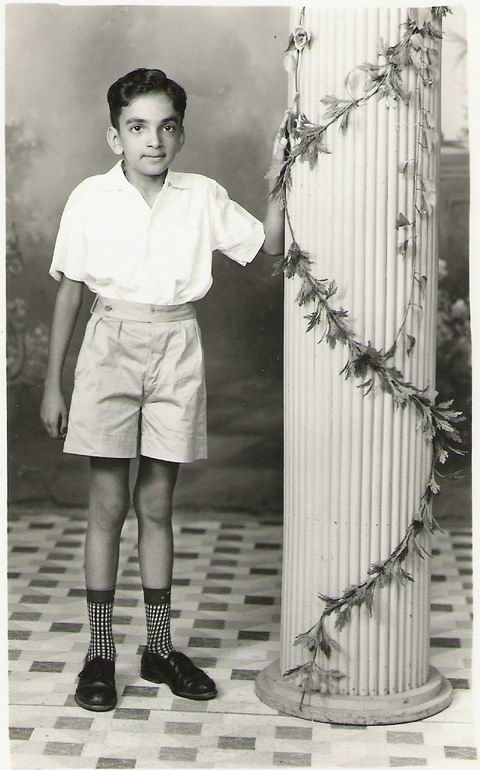
Dhanesh in 1963, age 11, in a photo studio.
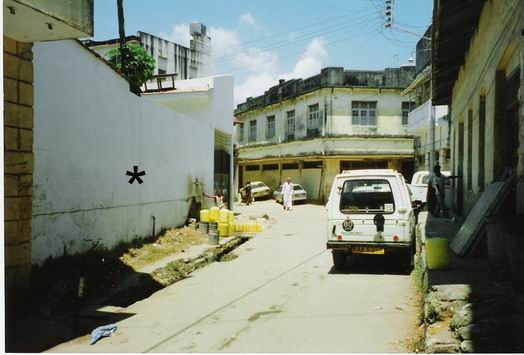
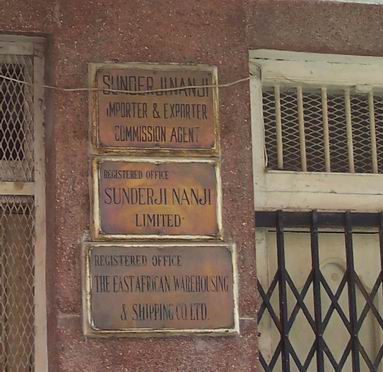
The "old house" location (marked *) and its neighborhood, including the nameplates fom the business that once thrived here.


Africa contains Kenya, and Kenya contains Mombasa!
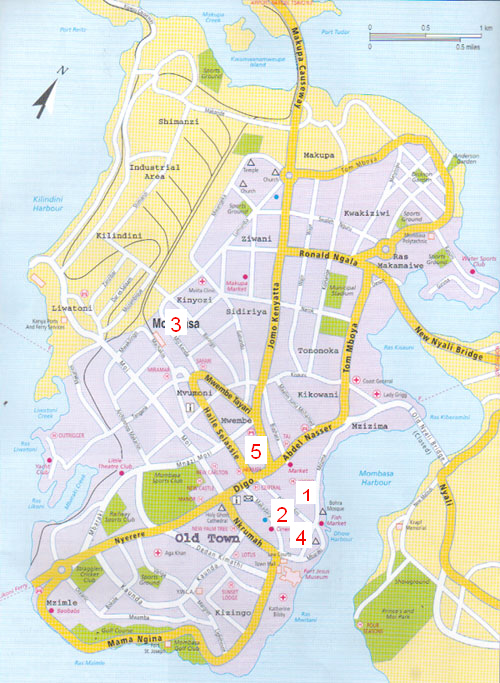
Map of Mombasa island, showing the residences of our family: 1 ("junu ghar" 1941-1952), 2 ("narshibhai" 1952-1953), 3 ("station walla" 1953-1954), 4 ("ganda nu ghar " 1954-1960), & 5 ("market mansion" 1960-1974). The residences 1 and 4 lie in the old town area near Fort Jesus and the Old Port.
Likoni Ferry, connecting Mombasa island to the mainland to the south, was not that crowded during those days. Mombasa must have grown 4 to 5 times or more in population today (2005) since my childhood.
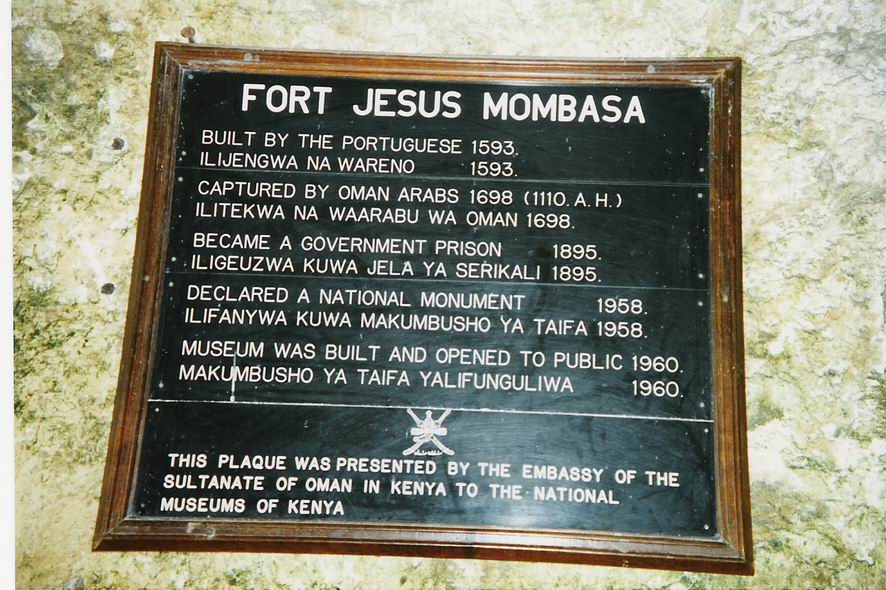
Some other interesting memories I have from around 1951-52 in this "old house", concern the arabs who came in their dhows with the seasonal monsoon winds. They slept on the footpath outside the "old house" and tried to communicate a little with us children. My memories of them are still stronger from the years later on in my childhood. The monsoon winds blew southwards from the Arabian Peninsula during November, December, January, when the arabs came in their dhows and brought with them, what I remember, dates, walnuts, dried fruit, and woven baskets & hand-fans. I would think they also brought dried fish, but being vegetarians, we were not involved in experiences with fish, though I could smell them in some quarters. The arabs went around on the streets and to the shop-owners, and sold these items. We welcomed their presence, since they had affordable prices and there were many of them going around, dressed in typical white arab dresses. My father used to buy sizable quantities of walnuts, dates, figs, and dried fruit, which we loved. The "old house" was situated very near the "old port", where the dhows anchored.
The old port used to be very busy in those days, with many dhows anchored, but nowadays (pictures above), it looks like almost deserted. (The main big harbor of Mombasa is Kilindini Harbor.) There was some weak rumour when I was a child, that sometimes children were abducted by these dhow-men and taken to their home country in the Arabian Peninsula. So we were advised by the adults to be careful. I do not know how much truth lay in this rumour. But having heard the history of the slave trade from the coast in the previous century, one did not want to take chances. A lucrative slave trade had existed along the coast from around the 18th century, which due to pressure from the British public, was finally banned in 1877. This building opposite the Fort Jesus (above), now used as a money exchange bureau, was in the earlier century used as a market for slave trade. The slaves were usually transported away from the Old Port (below). |
Wonderful Diwali brought with it the delicious sweets I loved, like bundi ke laddu (above right). Some other favorites were gulab jaman (below left) and jalebi (below right).
To learn all about Diwali, click here.
Ghughras (above) were something special for Diwali, it is watering in my mouth as I write this...
 |
Simple, but cosy Diwali abroad, Oct 2006. |
Sometime during our stay at Narshibhai house, I remember that there was a discussion in the family, whether we should buy a radio or a bunk bed (two on each other) with the limited money we had. Due to disagreement, they said that I, as the youngest who could talk, should have the final word. My brothers talked me into saying that we should buy a radio, which we did.
The railway system linking the interiors of Kenya and Uganda to the Indian Ocean at Mombasa started in 1896 and continued upto the mid-20th century. The Asian workers, from British India, were the first of many who emigrated to the region bringing much needed technical and entrepreneurial skills.
My photo taken after 51 years, of the place where I started with my first day in school, the nursery school called the Brahmo Samaj in Mombasa, which is now rebuilt somewhat.
| In my childhood, the railway link to Jinja in Uganda was of particular significance. This is because Manorama, our eldest sister and sibling, moved to Jinja when she got married in 1951 when I was barely three years old. We all loved her, and still do (she is now 74 and like a mother to us after our mother passed away in 1989) and we loved her coming to Mombasa by train with her children, although it occurred many years apart. | |
 |
 |
Manorama with her husband sometime in their youth...
|
I have never seen Manorama wearing this dress, except in the photo taken long ago (I remember seeing her only wearing a sari). |
Manorama and her husband GP in Canada, 2004. |
|




